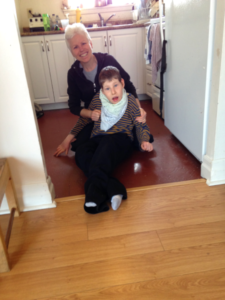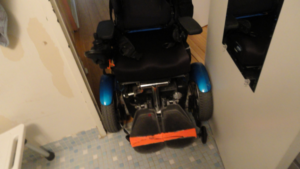Unitarian Commons is founding member of the Accessible Housing Network, a non-partisan collaboration of Canadian non-profit organizations working to support the human rights of persons with disabilities to end the extreme lack of accessible housing. AccessibleHousingNetw
What is Universal Design? Why do we need it?
Universal design will accommodate everyone of any age or ability. True universal design goes beyond mere accessibility. It demonstrates an underlying commitment to including as wide a range of users as possible.The Older Women’s Network housing committee is calling for a change to federal and provincial building codes to require that all new multi-unit buildings be universal design.
The Accessibility for Ontarians with Disabilities Act does not include housing. It regulates accessibility of public buildings and businesses.We need innovative housing which is affordable, barrier-free, multi-generational and promotes the building of community.Disabilities play no favourites. Anyone of any age can have been born with a disability or can be struck by illness or accident which creates a temporary or lasting injury. We have all heard of the cyclist hit by a truck and the stroke patient who cannot return home to an inaccessible apartment. Nobody should be made homeless due to accident or illness.
Universal accessibility is a human rights issue
Under the 2007 UN Convention on the Rights of People with Disabilities, member states “recognize the equal right of all persons with disabilities to live in the community, with choices equal to others, and shall take effective and appropriate measures to facilitate full enjoyment by persons with disabilities of this right and their full inclusion and participation in the community, including by ensuring that:
a. …the opportunity to choose their place of residence and where and with whom they live on an equal basis with others and are not obliged to live in a particular living arrangement;
b. … access to a range of in-home, residential and other community support services, including personal assistance necessary to support living and inclusion in the community, and to prevent isolation or segregation from the community”. (UN, Article 19 – Living independently and being included in the community)
The Canadian Charter of Rights and Freedoms and the Ontario Human Rights Code both ban discrimination based on age or disability.
However, the Accessibility for Ontarians with Disabilities Act (AODA) does not include housing. The Ontario Building Code merely requires that 15% of apartments be “visitable”, not livable. Thus, both contravene the Charter and the Ontario Human Rights Code.
Living in Place Campaign
“Living in Place”©, a campaign of the Older Women’s Network housing committee, advocates that federal and provincial building codes be changed to require that all units in new multi-unit residential buildings be entirely universal design.
Disabilities play no favourites. Anyone can have been born with a disability, and anyone of any age can be struck by illness or accident which creates a temporary or lasting injury. One out of every five Canadians lives with some form of disability.
Universal design will accommodate anyone of any age or ability, going beyond mere accessibility. It demonstrates an underlying commitment to including as wide a range of users as possible. Barrier-free housing should be a human right. Age-ism and able-ism are the last frontiers of discrimination.
The Living in Place© campaign has been endorsed by Toronto City Council. As Mayor John Tory says of the proposal to make all new apartments universal design: “It’s a no-brainer.” As the next step in the campaign, the Older Women’s Network is calling on everyone to write to their provincial and federal politicians, urging the change in the Building Codes.
Learn more: Thea Kurdi, an Architectural Accessibility and Universal Design Specialist, explains
toronto.ca/legdocs/mmis/2016/ah/bgrd/backgroundfile-94585.pdf
People of all ages need barrier-free homes

Aidan in wheelchair at lip on threshold in entrance
Pamela Andrews struggles to get her 13-year-old son in or out of their downtown Toronto apartment.
“The small lip on the threshold is very difficult to navigate in the power wheelchair”, she says. “It doesn’t look big, but it makes it very difficult to enter, and Aidan can’t get into the apartment by himself. I have to turn him backwards and push the chair in while the power is on full throttle.”The only entrance to the apartment is from an outdoor hallway. Pamela explains, “Yes, snow has to be shovelled on our outdoor hallways. Aidan’s wheelchair is pretty good in a few inches of snow, but not all wheelchairs are.”
Aidan, who has cerebral palsy and does not speak, is working toward learning to walk. At home, he hitches himself along the floor, and has learned to get into bed.
Life would have been much easier if their apartment had been barrier-free from the time Aidan was younger, and Pamela wishes they had a bigger apartment where a larger walker would fit. She needs a larger space with a roomy foyer, and a bigger bathroom with the possibility of installing a lift to help her move Aidan into and out of the bathtub now that he is growing so much heavier.
As they live in a rented co-op apartment, it is not possible to do much in the way of renovations. She has made only minor modifications to the apartment, such as easy-to-turn handles on the bathroom sink. The bathroom entrance is too small for Aidan’s wheelchair.
Pamela would like to have a kitchen with a counter designed so Aidan’s wheelchair can access it, as Aidan loves to help cook. Because there are no doors on the kitchen, Pamela cannot shut it off. So she has to get up early before the children awake to do any cooking & baking. She is afraid Aidan might open the hot oven door and burn himself.
Pamela expresses appreciation for the support of neighbours. The co-op replaced the carpet with laminate flooring so Aidan could use his walker, redid the foyer to protect it from denting by the wheelchair, provided extra storage space for his equipment, and put in new doors with easy to open lever handles. Because she does not own the apartment, she has been unable to get March of Dimes renovation funding.
Pamela says that she has community in the co-op, where she knows everyone. It would be difficult to move now, even if a barrier-free unit were to be found. “I did consider moving at one point to an accessible apartment. We would have to get on a waiting list, wait a few years (until someone died likely). But then Aidan would become an adult, and my daughter and I would have to move again. Stability is important for me. Plus I like this building. We have a community here in this neighbourhood and in this building. So I stay. Its not great for Aidan, but its good for our family.” She worries: “ When Aidan is older, he will need his own universal design place. – But where can he go?”
Why the caregiver and the wheelchair rider need universal design in their apartment
“Jane” (not her real name), age 36, is the primary caregiver for “Louise” who has
MS. Jane wrote:
If homes are built with Universal Design, it would allow my roommate, Louise, to enter and exit the apartment and building independently. This would free me from scheduling my day and work hours around her trips in and out of the home. She would also be able to enter the washroom/kitchen to wash her hands in the sink, to bathe in the bathroom and not on the bed/wheelchair. This would make it easier for me to assist her with her daily hygiene and require less strain on my back when helping her perform these tasks.
Universal design would also have spaces designed to accommodate assistive devices like a Hoyer lift to transfer Louise between the bed and her wheelchair.
For now, it takes a fair bit of shuffling and removing of dressers and normal bedroom storage furniture to make room for a lift.I would love to have an accessible kitchen where Louise could participate in
meal preparation and have access to the balcony to enjoy the garden or the
view. She loves cooking and has not been able to participate in meal
preparation for more than 4 years.We should be able to utilize every part of our living space, especially the common spaces that are usually shared.
Louise, age 45, who uses a 500 pound electric wheelchair due to MS, wrote:
Universal design would enable me to do fundamental things that most people take for granted. I would be able to open the front door to my apartment because I would have a device that would unlock it and hold it open, and the doorway would have no lintels or barriers that I would need assistance crossing. My apartment building would have similar devices in the hallways and throughout the building so I would be able to move freely and socialize as I liked.
Right now, if I don’t have help leaving my apartment, I have to stay home. In the world with Universal Design, my bathroom would have a doorway wide enough for a wheelchair, and it would have a shower that I could drive into. That would make the difference between being able to wash my hair in the shower, and having my hair washed over a basin in the hallway.
The social importance of universal design can’t be ignored either. Too many discussions with family or friends about plans for get-togethers and celebrations finish with the sad conclusion that I won’t be able to participate because stairs prevent me from even getting into their building. It’s gotten to the point where I assume that I won’t be able to take part in social gatherings because if I can’t get around in my own living space, why should I expect that I would be able to in
anyone else’s?

